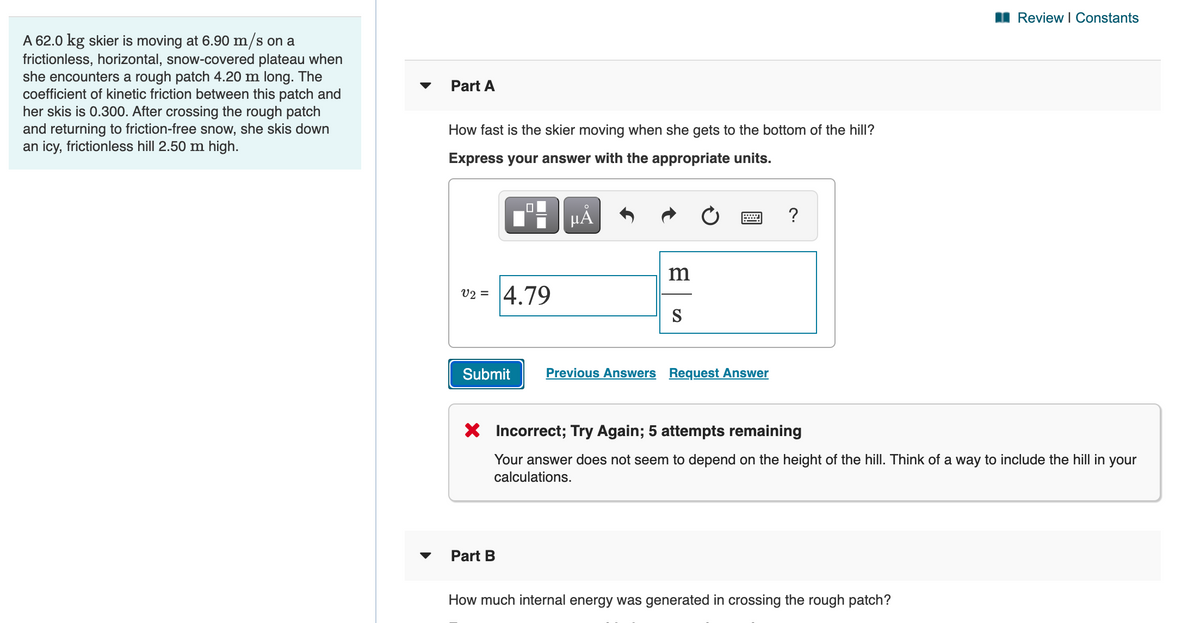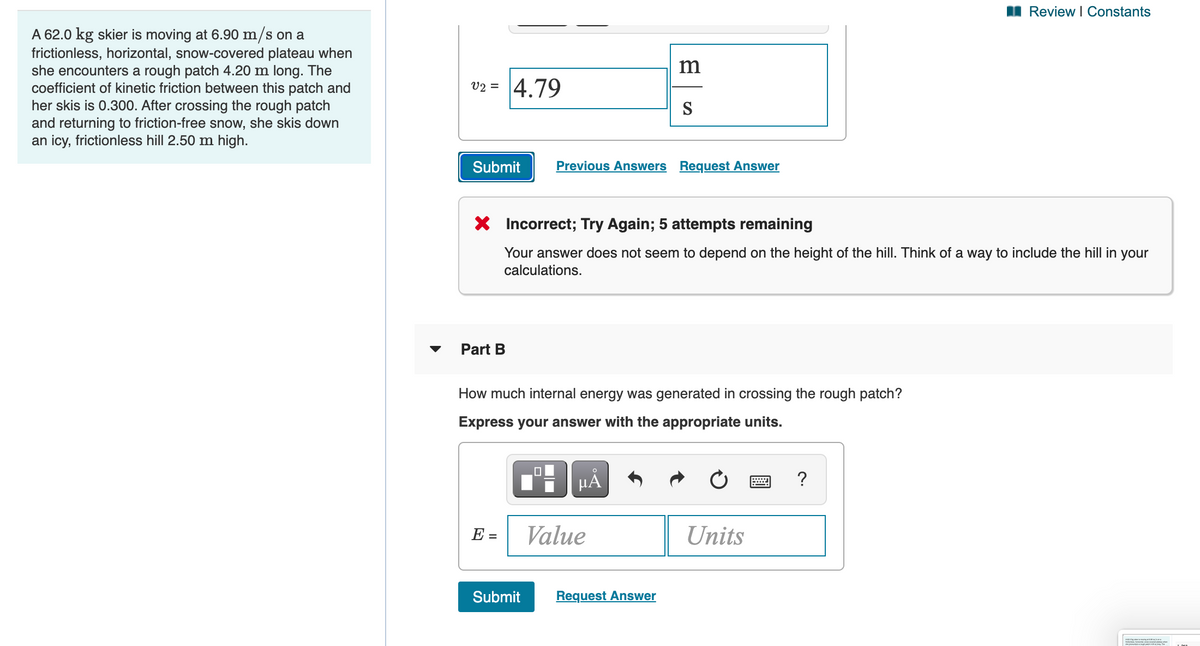Review I Constants A 62.0 kg skier is moving at 6.90 m/s on a frictionless, horizontal, snow-covered plateau when she encounters a rough patch 4.20 m long. The coefficient of kinetic friction between this patch and her skis is 0.300. After crossing the rough patch and returning to friction-free snow, she skis down an icy, frictionless hill 2.50 m high. Part A How fast is the skier moving when she gets to the bottom of the hill? Express your answer with the appropriate units. HA ? m v2 = 4.79 S Submit Previous Answers Request Answer X Incorrect; Try Again; 5 attempts remaining Your answer does not seem to depend on the height of the hill. Think of a way to include the hill in your calculations. Part B How much internal energy was generated in crossing the rough patch?
Review I Constants A 62.0 kg skier is moving at 6.90 m/s on a frictionless, horizontal, snow-covered plateau when she encounters a rough patch 4.20 m long. The coefficient of kinetic friction between this patch and her skis is 0.300. After crossing the rough patch and returning to friction-free snow, she skis down an icy, frictionless hill 2.50 m high. Part A How fast is the skier moving when she gets to the bottom of the hill? Express your answer with the appropriate units. HA ? m v2 = 4.79 S Submit Previous Answers Request Answer X Incorrect; Try Again; 5 attempts remaining Your answer does not seem to depend on the height of the hill. Think of a way to include the hill in your calculations. Part B How much internal energy was generated in crossing the rough patch?
College Physics
11th Edition
ISBN:9781305952300
Author:Raymond A. Serway, Chris Vuille
Publisher:Raymond A. Serway, Chris Vuille
Chapter6: Momentum, Impulse, And Collisions
Section6.3: Collisions In One Dimension
Problem 6.5QQ: A skater is using very low-friction rollerblades. A friend throws a Frisbee to her, on the straight...
Related questions
Question

Transcribed Image Text:I Review I Constants
A 62.0 kg skier is moving at 6.90 m/s on a
frictionless, horizontal, snow-covered plateau when
she encounters a rough patch 4.20 m long. The
coefficient of kinetic friction between this patch and
her skis is 0.300. After crossing the rough patch
and returning to friction-free snow, she skis down
an icy, frictionless hill 2.50 m high.
Part A
How fast is the skier moving when she gets to the bottom of the hill?
Express your answer with the appropriate units.
HẢ
m
v2 = 4.79
S
Submit
Previous Answers Request Answer
X Incorrect; Try Again; 5 attempts remaining
Your answer does not seem to depend on the height of the hill. Think of a way to include the hill in your
calculations.
Part B
How much internal energy was generated in crossing the rough patch?

Transcribed Image Text:I Review I Constants
A 62.0 kg skier is moving at 6.90 m/s on a
frictionless, horizontal, snow-covered plateau when
she encounters a rough patch 4.20 m long. The
coefficient of kinetic friction between this patch and
her skis is 0.300. After crossing the rough patch
and returning to friction-free snow, she skis down
an icy, frictionless hill 2.50 m high.
m
v2 = 4.79
S
Submit
Previous Answers Request Answer
X Incorrect; Try Again; 5 attempts remaining
Your answer does
ot seem to depend on the height of the hill. Think
a way
include
hill in your
calculations.
Part B
How much internal energy was generated in crossing the rough patch?
Express your answer with the appropriate units.
HẢ
?
E =
Value
Units
Submit
Request Answer
Expert Solution
This question has been solved!
Explore an expertly crafted, step-by-step solution for a thorough understanding of key concepts.
This is a popular solution!
Trending now
This is a popular solution!
Step by step
Solved in 2 steps

Knowledge Booster
Learn more about
Need a deep-dive on the concept behind this application? Look no further. Learn more about this topic, physics and related others by exploring similar questions and additional content below.Recommended textbooks for you

College Physics
Physics
ISBN:
9781305952300
Author:
Raymond A. Serway, Chris Vuille
Publisher:
Cengage Learning

Principles of Physics: A Calculus-Based Text
Physics
ISBN:
9781133104261
Author:
Raymond A. Serway, John W. Jewett
Publisher:
Cengage Learning

University Physics Volume 1
Physics
ISBN:
9781938168277
Author:
William Moebs, Samuel J. Ling, Jeff Sanny
Publisher:
OpenStax - Rice University

College Physics
Physics
ISBN:
9781305952300
Author:
Raymond A. Serway, Chris Vuille
Publisher:
Cengage Learning

Principles of Physics: A Calculus-Based Text
Physics
ISBN:
9781133104261
Author:
Raymond A. Serway, John W. Jewett
Publisher:
Cengage Learning

University Physics Volume 1
Physics
ISBN:
9781938168277
Author:
William Moebs, Samuel J. Ling, Jeff Sanny
Publisher:
OpenStax - Rice University